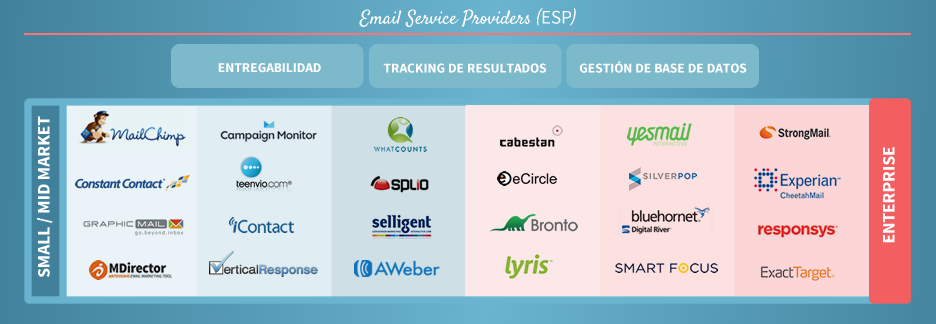Email Marketing Tools: Email Services Providers (ESPs)
ESPs have been the pioneers of Email Marketing as we understand it today. They are platforms aimed at sending mass campaigns whose main added value revolves around the following axes:
The deliverability of emails or deliverability.
One of the key aspects when carrying out mass email marketing actions has to do with the level of email deliverability in users' inboxes. Each time the filters through which an email passes are tougher, since the aim of email providers such as Yahoo, Gmail or Outlook.com and of email client solution providers (Outlook, Thunderbird, Lotus) is to allow incoming requested and relevant content for the user. In other words, many emails are filtered out as spam. From a technical point of view, ESPs are prepared to optimise the delivery of large volumes of emails in the inbox through proper management of database hygiene and sender reputation in general.
The ability to trace the results of actions.
By means of a tracking system, these tools make it possible to trace the actions that a user has taken once an email has been delivered: when and how many times they have opened it, which links they have clicked on, if they have marked it as spam, if they have unsubscribed, etc... This will allow, on the analytical side, to control the performance of the different campaigns to be implemented.
Database management.
The management of the database involves, on the one hand, the ability to manage in real time the status of users: registrations, cancellations, responses, etc. On the other hand, it involves the ability to quickly and user-friendly segment the database, both from the point of view of socio-demographic information (gender, age, postcode, product) and behavioural information (openers, non-openers, those who have clicked on a particular content, etc.). ). ESPs incorporate functionalities that allow for the proper management of subscriber status as well as list segmentation.

ESPs can be classified according to whether they target small and medium-sized enterprises (Small and Middle Market) or large enterprises (Enterprise).
- Small and Mid Market: are suitable solutions for sending small to medium volumes of emailings (tens of thousands). They are usually agile and cost-effective solutions. The main drawbacks of this type of platform are the inability to adequately manage very massive mailings (millions), the limitations of integration and automation (they usually lack APIs), and the absence of teams dedicated exclusively to deliverability management.
- Enterprise: Enterprise level ESPs allow sending large volumes of email and are highly scalable. They also have flexible integration APIs and can be connected to other platforms via FTP and web services. One of the major differences between this level of ESPs and the previous ones is the dedication of human resources to the management of optimal deliverability, both from the point of view of the relationship with ISPs (Internet Service Providers) and the constant monitoring of the sender's reputation. Another differentiating element of Enterprise level ESPs is the investment in support teams in the different countries (or regions) where they operate.